William Frederick Yeames (1835-1918) stands as a significant, if sometimes overlooked, figure in the landscape of 19th-century British art. A master of the historical genre, Yeames possessed a remarkable ability to distill complex historical narratives and poignant human emotions into meticulously rendered canvases. His work, deeply embedded in the Victorian era's fascination with the past, often explored themes of loyalty, conflict, and personal sacrifice, resonating powerfully with his contemporaries and continuing to engage audiences today. Born into a world of diplomatic privilege yet shaped by personal and financial vicissitudes, Yeames's artistic journey took him from the Imperial grandeur of Russia to the artistic heartlands of Germany, Italy, and finally, to the bustling art scene of London, where he would make his indelible mark.
An International Upbringing and Early Artistic Inclinations
William Frederick Yeames was born on December 18, 1835, in Taganrog, a port city on the Sea of Azov in Southern Russia. This exotic birthplace was a consequence of his father, William Yeames, serving as the British Consul to Russia. His mother was also British, ensuring that despite his Russian birth, his cultural and familial ties remained firmly rooted in Britain. This early exposure to a different culture, coupled with the family's prominent social standing, likely broadened the young Yeames's horizons from a tender age.
The idyll of his early childhood was tragically interrupted in 1842 with the death of his father. Following this loss, the family relocated, and Yeames was sent to Dresden, Germany, to receive his education. It was in Dresden, a city renowned for its rich artistic heritage and magnificent collections, that his formal instruction in drawing and painting began. This period was crucial in laying the foundational skills that would underpin his later career. He immersed himself in the study of the Old Masters, a practice considered essential for any aspiring artist of the time.
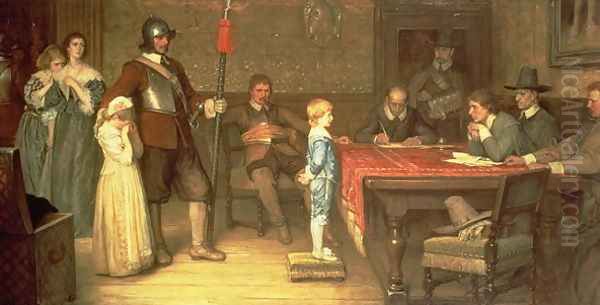
However, the family's circumstances took another turn in 1848. A significant collapse in the family's finances necessitated a move to London. This change, while driven by necessity, placed the young Yeames at the epicenter of the British art world. In London, he continued his artistic training with earnest dedication. He studied under George Scharf, a distinguished art historian and illustrator who later became the first director of the National Portrait Gallery. Under Scharf's tutelage, Yeames honed his skills in anatomy and composition, two pillars of academic art training. He also received instruction from F.A. Westmacott, further solidifying his technical grounding.
The Italian Sojourn: Immersing in the Renaissance Masters
The allure of Italy, with its unparalleled artistic treasures and its status as the cradle of the Renaissance, was irresistible for ambitious young artists of the 19th century. In 1852, at the age of seventeen, William Frederick Yeames embarked on his own Italian pilgrimage, a journey that would profoundly shape his artistic vision. He made his way to Florence, a city synonymous with artistic innovation and home to masterpieces by some of history's greatest artists.
In Florence, Yeames sought out established masters to guide his studies. He became a pupil of Enrico Pollastrini, a respected painter and professor at the Accademia di Belle Arti di Firenze, known for his historical and religious subjects. He also studied with Raffael Buonajuti (sometimes recorded as Raffael Buonuomo), further steeping himself in the techniques and aesthetics of the Italian school. A critical part of his Florentine education involved the meticulous copying of works by Renaissance luminaries. He spent considerable time studying and replicating the frescoes of Domenico Ghirlandaio, Benozzo Gozzoli, and Andrea del Sarto, absorbing their mastery of narrative, figure drawing, and compositional harmony.
After his intensive studies in Florence, Yeames traveled to Rome. The Eternal City offered a different, though equally enriching, artistic environment. In Rome, he focused on landscape studies, capturing the picturesque Roman Campagna, and continued his engagement with classical and Renaissance art. He is known to have copied Raphael's frescoes in the Vatican, an experience that would have deepened his understanding of monumental composition and idealized human form. This extended period in Italy, lasting several years, was not merely about technical skill acquisition; it was an immersion in the spirit of historical art, which would become the hallmark of his own oeuvre. He returned to England in 1859, equipped with a sophisticated understanding of European art traditions and ready to launch his professional career.
The St John's Wood Clique: A Fellowship of History Painters
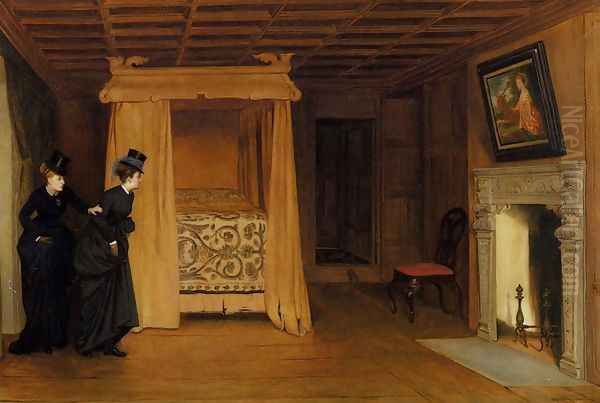
Upon his return to London in 1859, Yeames established a studio in Park Place and quickly became associated with a group of like-minded young artists who would become known as the St John's Wood Clique. This informal brotherhood of painters shared a common interest in historical and literary subjects, often rendered with a strong narrative and anecdotal flavour, appealing to the Victorian taste for storytelling in art. The group was characterized by its camaraderie and mutual support, often meeting to discuss their work and share ideas.
The leading figure of the St John's Wood Clique was Philip Hermogenes Calderon, a painter of Spanish and French parentage who, like Yeames, specialized in historical genre scenes. Other core members included George Adolphus Storey, known for his charming historical and domestic scenes; David Wilkie Wynfield, who was also a notable photographer, famous for his series of artists in period costume; and Henry Stacy Marks, who often painted humorous subjects from Shakespeare and medieval history. While sources sometimes vary on the extended membership, William Goodall, a painter from a family of artists, is also noted as having connections and collaborations within this circle.
The Clique was known for its members' dedication to historical accuracy in costume and setting, a characteristic that Yeames embraced wholeheartedly. They often chose subjects from British history, particularly the Tudor and Stuart periods, which were rich in dramatic incident and colourful personalities. A fascinating aspect of their working method was their occasional practice of renting Hever Castle in Kent, the childhood home of Anne Boleyn. This historic location provided an authentic backdrop and an inspiring atmosphere for their historical reconstructions, allowing them to immerse themselves in the period they sought to depict. Yeames's involvement with the St John's Wood Clique was formative, providing him with a supportive peer group and reinforcing his commitment to historical narrative painting.
Gaining Recognition: The Royal Academy and Early Successes
The Royal Academy of Arts was the preeminent institution in the British art world of the 19th century, and exhibition at its annual Summer Exhibition was crucial for an artist's reputation and commercial success. William Frederick Yeames made his debut at the Royal Academy in 1859, the same year he returned from Italy. He exhibited two works: The Staunch Friend and The Portrait of Mr. B. W. of Chatsworth. This marked the beginning of a long and distinguished relationship with the Academy.
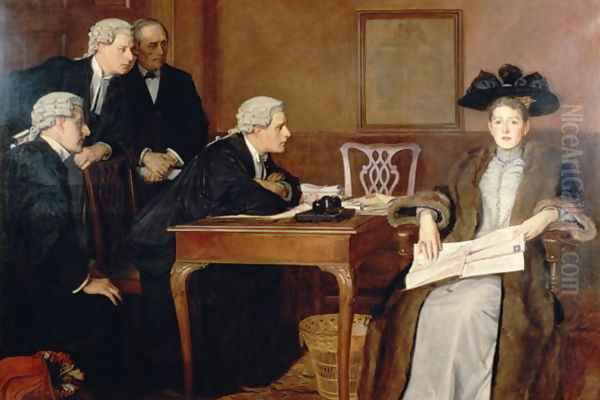
His paintings, characterized by their careful draughtsmanship, rich detail, and engaging narratives, quickly found favour with both the public and the critics. He continued to exhibit regularly, and his reputation grew steadily. His subjects often drew upon dramatic historical episodes or poignant literary themes, appealing to the Victorian fondness for storytelling and moral reflection. An early work, The Trysting House (1860), was significant enough that it was later donated to the British Museum, indicating its perceived quality and importance.
Yeames's rising prominence was formally recognized by the Royal Academy. In 1866, he was elected an Associate of the Royal Academy (ARA), a significant step in an academic artist's career. This was followed twelve years later, in 1878, by his election as a full Royal Academician (RA), the highest honour the institution could bestow. These accolades cemented his position as one of Britain's leading historical painters. Beyond the Royal Academy, Yeames also exhibited his works at other important venues, including the British Institution, the Dudley Gallery, and the French Gallery, ensuring his art reached a wide audience.
Signature Works: Capturing History's Defining Moments
Throughout his career, William Frederick Yeames produced a body of work that vividly brought history to life. Several of his paintings became iconic representations of their subjects, celebrated for their technical skill, emotional depth, and narrative power.
And When Did You Last See Your Father? (1878)
Arguably Yeames's most famous and enduring work, And When Did You Last See Your Father? is a masterpiece of historical drama and psychological tension. Exhibited at the Royal Academy in 1878, the painting depicts a poignant scene from the English Civil War. A young Royalist boy, dressed in elegant attire, stands before a panel of stern-faced Parliamentarian interrogators. His family – his mother and sisters, anxiously watch from the side. The central question, posed by the lead interrogator, hangs heavy in the air, forcing the boy into a terrible dilemma: to betray his father or endanger his family.
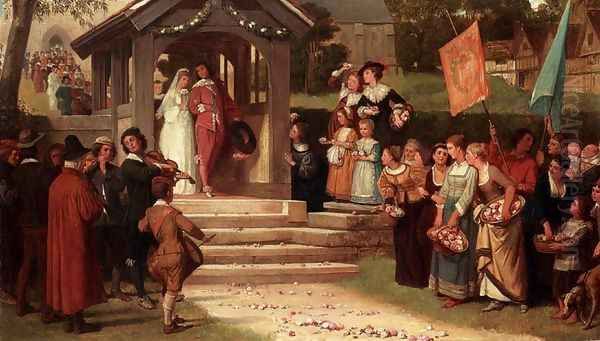
The composition is masterful, drawing the viewer's eye to the small, defiant figure of the boy. Yeames brilliantly captures the varied emotions of the characters: the boy's innocent resolve, the interrogators' grim determination, and the family's palpable fear and distress. The meticulous attention to period costume and interior detail lends an air of authenticity to the scene. The painting struck a chord with the Victorian public, who were fascinated by the Civil War period and appreciated the work's emotional intensity and moral complexity. It became so popular that it was widely reproduced and even inspired a tableau vivant and later a waxwork display at Madame Tussauds and subsequently at the Tower of London. Today, this iconic painting is a prized possession of the Walker Art Gallery in Liverpool.
Amy Robsart (1877)
Painted a year before his most famous work, Amy Robsart (1877) tackles another dramatic episode from English history, this time from the Elizabethan era. The painting depicts the tragic death of Amy Robsart, the wife of Robert Dudley, Earl of Leicester, a favourite of Queen Elizabeth I. Amy Robsart died in mysterious circumstances, falling down a flight of stairs, and rumours abounded that she was murdered to clear the way for Dudley to marry the Queen.
Yeames's painting captures Amy at the top of a staircase, her face etched with fear and despair, as shadowy figures lurk below. The composition creates a powerful sense of foreboding and impending doom. The work was likely inspired by Sir Walter Scott's novel Kenilworth, which popularized the romantic and tragic story of Amy Robsart. Yeames's interpretation is rich in atmospheric detail, from the dark, oppressive interior to Amy's vulnerable pose. The painting showcases his skill in conveying intense emotion and creating a suspenseful narrative. This significant work is now part of the collection at Tate Britain, London.
The Meeting of Sir Thomas More and His Daughter After His Sentence of Death (1863)
An earlier but equally powerful work, The Meeting of Sir Thomas More and His Daughter After His Sentence of Death (1863), demonstrates Yeames's early mastery of historical pathos. The painting portrays the heart-wrenching final encounter between Sir Thomas More, the former Lord Chancellor of England, and his beloved daughter, Margaret Roper, after More has been condemned to death for refusing to accept King Henry VIII as the Supreme Head of the Church of England.
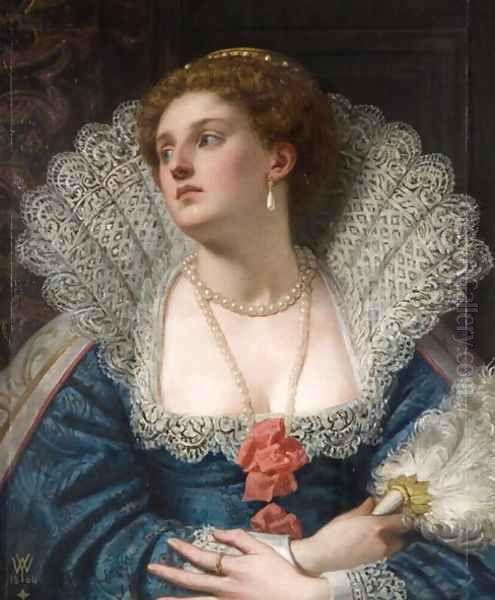
Yeames focuses on the emotional core of the scene: More's dignified resignation and spiritual strength contrasted with Margaret's overwhelming grief and love. The figures are rendered with sensitivity, their expressions and gestures conveying the depth of their bond and the tragedy of their parting. The historical setting is carefully delineated, adding to the scene's verisimilitude. This painting, which is held in a private collection, highlights Yeames's ability to explore themes of conscience, faith, and familial love within a historical framework. It is believed that fellow St John's Wood Clique associate William Goodall may have collaborated or provided assistance on aspects of this painting, underscoring the collaborative spirit of the group.
Defendant and Counsel (1895)
Later in his career, Yeames also explored contemporary subjects, often with a narrative ambiguity that characterized the "problem picture" genre popular at the end of the 19th century. Defendant and Counsel (1895) is a prime example. The painting depicts a scene in a barrister's chambers. A well-dressed woman, presumably the defendant, sits anxiously, while her legal team, three bewigged barristers, confer gravely.
The viewer is given few clues about the nature of the case or the woman's guilt or innocence. Instead, Yeames focuses on the psychological drama, the tension and uncertainty of the legal process. The expressions of the figures are carefully observed, inviting speculation about their thoughts and the potential outcome of the trial. The painting, now in the collection of the Bristol City Museum and Art Gallery, demonstrates Yeames's versatility and his keen observation of human behavior, even outside of historical settings.
Other Notable Works
Beyond these highlights, Yeames produced many other significant paintings. The Hidden Priest (1868-74), located in the National Gallery, London, explores the dangers faced by Catholic priests in Elizabethan England, a theme of religious persecution that resonated with Victorian audiences. In Service for the Poor (1868), also in the National Gallery, shows a more contemporary scene of nuns providing aid during a harsh winter, highlighting themes of charity and social concern. His early Royal Academy submission, The Staunch Friend (1859), and works like Chimney Sweep and The Jacobite Escape from the Powder Room at Cotehele Manor, Cornwall, further illustrate the range of his narrative interests, from intimate character studies to dramatic historical escapes. The Path Of Roses and A Visit To the Haunted Chamber are mentioned as modern decorative oil paintings, suggesting a breadth that might have included more allegorical or romantic themes alongside his historical narratives.
Themes, Style, and Artistic Approach
William Frederick Yeames's art is firmly rooted in the academic tradition, emphasizing strong drawing, balanced composition, and a high degree of finish. His style is characterized by its realism and meticulous attention to detail, particularly in the rendering of costumes, historical settings, and human physiognomy. He was a consummate storyteller, and his paintings are almost always narrative, inviting the viewer to engage with the events and emotions depicted.
His primary thematic interest lay in history, particularly British history of the 16th, 17th, and 18th centuries. The Tudor, Stuart, and Georgian periods provided him with a rich seam of dramatic incidents, political conflicts, and compelling human stories. He was drawn to moments of crisis, moral dilemma, and emotional intensity, as seen in works like And When Did You Last See Your Father? and The Meeting of Sir Thomas More and His Daughter. These paintings often explored universal themes such as loyalty, betrayal, courage, faith, and the impact of historical events on individual lives.
While historical subjects dominated his output, Yeames also painted scenes of contemporary life and "problem pictures" like Defendant and Counsel. These works demonstrate his keen observation of human psychology and social dynamics. In terms of technique, Yeames was a skilled colorist, using color to enhance the mood and drama of his scenes. His compositions are generally carefully structured, guiding the viewer's eye through the narrative. He often employed dramatic lighting to heighten the emotional impact and focus attention on key figures or moments.
His association with the St John's Wood Clique reinforced his commitment to historical accuracy. The group's practice of using authentic locations like Hever Castle and their shared interest in period detail contributed to the convincing realism of their historical reconstructions. Yeames's work, while academic, was rarely dry or overly didactic. He had a talent for imbuing his historical scenes with genuine human emotion, making them accessible and engaging for a wide audience. He was less inclined towards the overt symbolism of the Pre-Raphaelites, such as Dante Gabriel Rossetti or John Everett Millais in his early phase, or the classical idealism of contemporaries like Frederic Leighton or Lawrence Alma-Tadema. Instead, Yeames carved a niche for himself as a painter of historical genre, focusing on the human element within historical narratives.
A Circle of Contemporaries
Yeames did not operate in an artistic vacuum. His career unfolded during a vibrant period in British art, and he was connected to many of his contemporaries, most notably through the St John's Wood Clique. His close association with Philip Hermogenes Calderon, George Adolphus Storey, David Wilkie Wynfield, Henry Stacy Marks, and William Goodall provided a supportive network for artistic exchange and development. They shared not only a thematic focus but also a commitment to academic standards of painting.
Beyond the Clique, the broader London art world was populated by numerous talented artists. Figures like Sir John Everett Millais, who had moved from Pre-Raphaelitism to become a highly successful and versatile academic painter, and Frederic Leighton, President of the Royal Academy, known for his classical subjects, were dominant figures. William Powell Frith was another highly popular contemporary, famous for his panoramic scenes of modern Victorian life, such as Derby Day and The Railway Station. While Yeames's focus was more historical, he shared with Frith a talent for narrative and detailed observation.
His teachers also form part of his artistic lineage: George Scharf in London, and Enrico Pollastrini and Raffael Buonajuti in Florence, all contributed to his technical and conceptual development. The Old Masters he copied – Ghirlandaio, Gozzoli, Andrea del Sarto, and Raphael – were, in a sense, his most profound and lasting influences, shaping his understanding of composition, form, and narrative grandeur. The artistic environment of the Royal Academy, with its exhibitions and internal politics, would have brought him into contact with virtually every significant British artist of his time.
Later Life, Educational Role, and Legacy
William Frederick Yeames continued to paint and exhibit throughout his long career. His dedication to his art was matched by his commitment to the Royal Academy, where he played an active role beyond merely exhibiting. From 1896 to 1911, he served as the Librarian of the Royal Academy, a position of considerable responsibility that involved overseeing the Academy's important collection of books and prints. He also served as an art examiner and, according to some sources, a professor, contributing to the education of younger generations of artists. This educational role underscores his standing within the academic art establishment.
In his personal life, Yeames married Anne Winfield, and the couple had three children. His later years were spent in Devon, a picturesque county in the southwest of England. He passed away in Teignmouth, Devon, on May 3, 1918, at the venerable age of 82.
William Frederick Yeames left behind a significant artistic legacy. His paintings, particularly And When Did You Last See Your Father?, became iconic images in British popular culture, reproduced countless times and deeply embedded in the national consciousness. He was a master of historical narrative, skillfully blending meticulous research with genuine human emotion. His work provides a valuable window into Victorian tastes and preoccupations, particularly the era's fascination with history and its moral lessons.
His contribution to the "problem picture" genre, though less extensive than his historical work, also marks him as an artist engaged with contemporary artistic trends. Today, his paintings are held in major public collections across the United Kingdom, including the Tate Britain, the National Gallery in London, the Walker Art Gallery in Liverpool, Manchester City Art Gallery, the Bristol City Museum and Art Gallery, and the Courtauld Institute of Art. The continued presence of his works in these institutions, and their appeal to both scholars and the general public, attests to his enduring importance in the story of British art. He remains a key figure for understanding the complexities and achievements of Victorian historical painting.
M. H. Stephen's writings and other academic studies have helped to preserve and analyze Yeames's contributions, ensuring that his life and work continue to be studied and appreciated. His ability to make history palpable and emotionally resonant ensures that his canvases still speak to us today, a testament to his skill as both a painter and a storyteller.